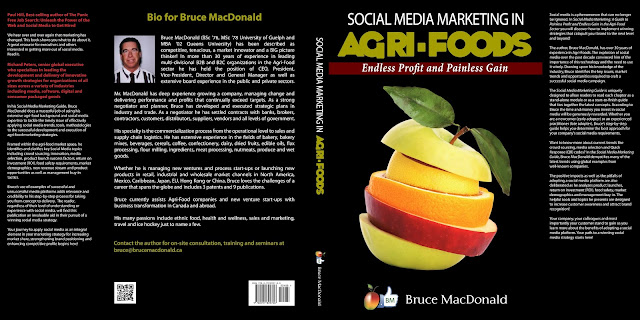SCIENTISTS DEVELOP CROP MODELS TO FORECAST FOOD PRODUCTION
Published June 10, 2013 in Food Product Design

Check out my latest e-book entitled: "Social Media Marketing in Agri-Foods: Endless Profit and Painless Gain".
LANSING, Mich.—An international team of scientists has developed crop models to better forecast food production in the face of climate change to feed a growing global population projected to reach 9 billion by 2050, according to a paper published in Nature Climate Change.
Members of the Agricultural Model Intercomparison and Improvement Project unveiled an all-encompassing modeling system that integrates multiple crop simulations with improved climate change models. AgMIP's effort has produced new knowledge that better predicts global wheat yields while reducing political and socio-economic influences that can skew data and planning efforts, said Bruno Basso, Michigan State University ecosystem scientist and AgMIP member.
"Quantifying uncertainties is an important step to build confidence in future yield forecasts produced by crop models," said Basso, with MSU's geological sciences department and Kellogg Biological Station. "By using an ensemble of crop and climate models, we can understand how increased greenhouse gases in the atmosphere, along with temperature increases and precipitation changes, will affect wheat yield globally."
The improved crop models can help guide the world's developed and developing countries as they adapt to changing climate and create policies to improve food security and feed more people.
Basso, part of MSU's Global Water Initiative, and his team of researchers developed the System Approach for Land-Use Sustainability (SALUS) model—a new generation crop tool to forecast crop, soil, water, nutrient conditions in current and future climates. It also can evaluate crop rotations, planting dates, irrigation and fertilizer use and project crop yields and their impact on the land.
SALUS was initially designed by Joe Ritchie, MSU emeritus distinguished professor. Basso continued Ritchie's work and added new features to better predict the impact of agronomic management on crop yield over space and time.
"We can change the scenarios, run them simultaneously and compare their outcomes," Basso said. "It offers us a great framework to easily compare different land-management approaches and select the most efficient strategies to increase crop yield and reduce environmental impact such as nitrate leaching and greenhouse gas emission."
For the study, the team looked at simulated yield from 27 different wheat crop models. Through SALUS, Basso forecasted the impact of changes in temperature, precipitation and CO2 emissions on wheat yield from contrasting environment across the planet.
SALUS has been employed in several other projects monitoring grain yield and water use in water-sensitive areas, such as the Ogallala aquifer (spanning from South Dakota to Texas), Siberia, India and Africa.
Members of the Agricultural Model Intercomparison and Improvement Project unveiled an all-encompassing modeling system that integrates multiple crop simulations with improved climate change models. AgMIP's effort has produced new knowledge that better predicts global wheat yields while reducing political and socio-economic influences that can skew data and planning efforts, said Bruno Basso, Michigan State University ecosystem scientist and AgMIP member.
"Quantifying uncertainties is an important step to build confidence in future yield forecasts produced by crop models," said Basso, with MSU's geological sciences department and Kellogg Biological Station. "By using an ensemble of crop and climate models, we can understand how increased greenhouse gases in the atmosphere, along with temperature increases and precipitation changes, will affect wheat yield globally."
The improved crop models can help guide the world's developed and developing countries as they adapt to changing climate and create policies to improve food security and feed more people.
Basso, part of MSU's Global Water Initiative, and his team of researchers developed the System Approach for Land-Use Sustainability (SALUS) model—a new generation crop tool to forecast crop, soil, water, nutrient conditions in current and future climates. It also can evaluate crop rotations, planting dates, irrigation and fertilizer use and project crop yields and their impact on the land.
SALUS was initially designed by Joe Ritchie, MSU emeritus distinguished professor. Basso continued Ritchie's work and added new features to better predict the impact of agronomic management on crop yield over space and time.
"We can change the scenarios, run them simultaneously and compare their outcomes," Basso said. "It offers us a great framework to easily compare different land-management approaches and select the most efficient strategies to increase crop yield and reduce environmental impact such as nitrate leaching and greenhouse gas emission."
For the study, the team looked at simulated yield from 27 different wheat crop models. Through SALUS, Basso forecasted the impact of changes in temperature, precipitation and CO2 emissions on wheat yield from contrasting environment across the planet.
SALUS has been employed in several other projects monitoring grain yield and water use in water-sensitive areas, such as the Ogallala aquifer (spanning from South Dakota to Texas), Siberia, India and Africa.
Sources:
- Michigan State University: How do you feed 9 billion people?
The book is available on Amazon and Kindle for $4.99 USD. Visit amazon/Kindle to order now:
http://www.amazon.ca/Social-Media-Marketing-Agri-Foods-ebook/dp/B00C42OB3E/ref=sr_1_1?s=digital-text&ie=UTF8&qid=1364756966&sr=1-1
Written by Bruce MacDonald, a 30 year veteran of the Agri-food industry, in "Social Media Marketing in Agri-Foods: Endless Profit and Painless Gain", Bruce applies his background and expertise in Agri-foods and social media to the latest trends, tools and methodologies needed to craft a successful on-line campaign. While the book focuses on the Agri-food market specifically, I believe that many of the points Bruce makes are equally applicable to most other industries.


No comments:
Post a Comment